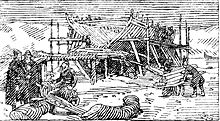Battle of Helgeå



The Battle of Helgeå was fought in 1025 , 1026 or 1027 - sources do not agree on the date - between England and Denmark on the one hand and Norway and Sweden on the other. The sea battle probably took place in the mouth of the Helge å river in what is now southern Sweden. The Anglo-Saxon Chronicle calls the river "holy river". Canute the Great , who led the Anglo-Danish army and ruled both England (1016-1035) and Denmark (1019 / 1020-1035), had previously claimed the Norwegian throne, which was given by Olav II. Haraldsson ( the fat, later the saint) was occupied since 1015. He made an alliance with the Swedish ruler Anund Jakob and began to attack the Danish islands.
The outcome of the battle is not clearly recorded. The Anglo-Saxon Chronicle speaks of a defeat of Knut, the contemporary sagas do not contradict this. However, Knut has received a letter from 1027 in which he describes himself as the king of all of England, Denmark, Norway and part of Sweden. This could indicate a victory for Knut. It is difficult to assess what significance the mention of Sweden actually has in this context. What is certain is that the victor could not gain prestige through this battle. The Norwegian aristocrats are said to have no longer stood loyally behind Olaf at this point, Sweden had participated because it wanted to prevent Knut from becoming too powerful in the north and Knut was primarily concerned with defending his Danish part of the empire. Knut got the Norwegian king title in 1028 through political propaganda.
The sources of this battle are extremely poor and, in addition to the Anglo-Saxon Chronicle, is limited to the Skaldendicht . Mainly Snorri Sturluson informs us about the process in Heimskringla by describing how Knut was surprised by the Norwegian-Swedish coalition in the river estuary and overpowered by a ruse. Due to the temporal distance, this version is doubtful in its details.
The opposing constellation, or who fought with whom against whom, is apparently also controversial: the Scandinavian and historian Ralph Tuchtenhagen claims that it was the Swedish King Anund Jakob who suffered a defeat at Helgeå in 1027 against Knut and Olav.
There are two rune stones that could refer to this / a battle between kings. One is the mask stone (DR 66) (also Aarhus 4), the other is the rune stone on the Råda kyrka (Vg 40). In each case one companion is lamented who “found death when the kings fought”.
Individual proof
- ↑ Ralph Tuchtenhagen : Little History of Sweden , page 147.Beck, Munich 2008
literature
- Alexander R. Rumble (Ed.): The Reign of Cnut. King of England, Denmark and Norway . Leicester University Press et al., London et al. 1994, ISBN 0-8386-3605-5 , ( Studies in the early history of Britain ).
- Laurence Marcellus Larson: Canute the Great. 995 (circ) -1035 and the rise of Danish imperialism during the Viking Age . Putnam, New York NY et al. 1912, ( Heroes of the nations ).